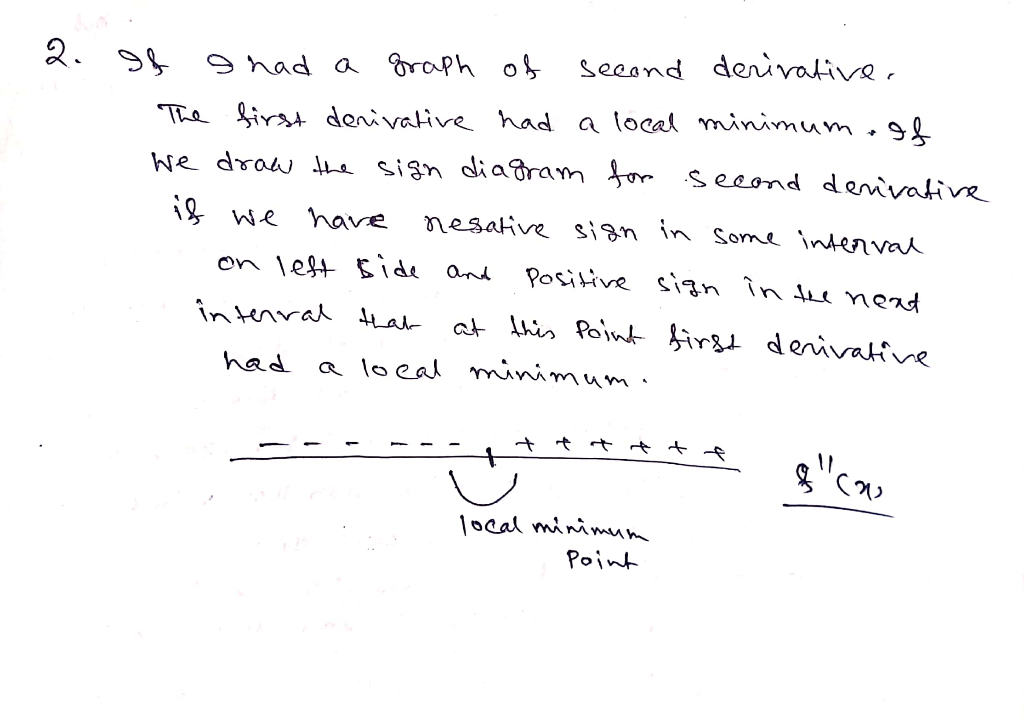Question
In: Math
1. If you only had a graph of the second derivative, how could you tell where...
1. If you only had a graph of the second derivative, how could you tell where the original function is concave down?
2. If you only had a graph of the second derivative, how could you tell where the first derivative had a local minimum?
Solutions
Related Solutions
(a) How do you find the second derivative of a function? (b) If both are positive numbers, what does that tell you about the function itself?
(a) How do you find the second derivative of a function?
(b) If both are positive numbers, what does that tell you about the function itself?
(c) If we know that a function is increasing, but at a decreasing rate, what does that say about the first and second derivatives?
(d) Come up with a function where the first and second derivatives are non-zero but the third derivative is zero.
1. If you looked at a drawing of a lipid, how could you tell whether it...
1. If you looked at a drawing of a lipid, how could you tell
whether it was saturated or unsaturated?
2. Describe an example of kinetic energy being transformed into
potential energy.
3. Describe an example of potential energy being transformed
into kinetic energy.
4. What makes something an organic molecule?
5. How can you tell if a solution is a good buffer or not?
What information about a graph can be found from the second derivative? Explain
What information about a graph can be found from the second
derivative? Explain
What does taking the derivative of a function tell you about the function? Is a derivative...
What does taking the derivative of a function tell you about the
function? Is a derivative a local property in the sense that you
can define the derivative of a function f(x) at x?
What does integrating a function tell you? Is an integral a
local property in the sense that you can define the integral of a
function f(x) at x?
If you first differentiate a function and then integrate it, are
you going to get the same function...
1. (3) How could you tell if a plant you have found is a sporophyte or...
1. (3) How could you tell if a plant you have found is a
sporophyte or a gametophyte? Use your imagination and describe an
experiment you could do.
2. (3) a. Explain why the sporophyte is “dependent” on
the gametophyte in the moss and the fern.
b. Which is the “dominant” form in each of
these?
How do you tell if a graph of a rational function has a hole in the...
How do you tell if a graph of a rational function has a hole in
the graph or a vertical asymptote? Give an example of each
case.
Find the local maximum and minimum values of the function. Tell the intervals where the graph...
Find the local maximum and minimum values of the function.
Tell the intervals where the graph of the function is increasing
and decreasing
f(x)= 2x^3 +3x^2 - 12x
Suppose you had an inverted “U-shaped” function. Describe what the first and second derivatives would tell...
Suppose you had an inverted “U-shaped” function.
Describe what the first and second derivatives would tell
you.
1) The graph of the derivative f ' of a continuous function f is shown. (Assume...
1) The graph of the derivative f ' of a continuous function f is
shown. (Assume the function f is defined only for 0 < x <
∞.)
(a) On what interval(s) is f increasing? (2a) On what
interval(s) is f decreasing?
(b) At what value(s) of x does f have a local
maximum? (2b) At what value(s) of x does f have a
local minimum? x=?
(c) On what interval(s) is f concave upward? (2c) On
what interval(s) is...
Describe how you could use a turbidity measurement to tell how many colonies you would expect...
Describe how you could use a turbidity measurement to tell how
many colonies you would expect from plating a culture of a given
OD.
Escherichia coli can grow at a higher temperature in a
complex medium than in a defined medium. Why?
What is Taq polymerase and why is important?
ADVERTISEMENT
ADVERTISEMENT
Latest Questions
- What artifacts, espoused values, enacted values and norms, and assumptions demonstrate the culture of Southwest Airlines?
- 1) 10000 lb/h of a 40.00% NaoH solution is crystallized through a combined evaporator-crystallizer process. The...
- STRICT DOWNVOTE IF NOT DONE FULLY, WILL REPORT ALSO IF COPY PASTED OR MODIFIED ANSWER Develop...
- The three questions are basically looking for an observation, asking the question and then giving the...
- YOU are the financial officer at an Austrian company that wants to BUY USD 1.000.000 of...
- Please read the whole program (all the way to the bottom), Thanks in advance! Develop car...
- A)Consider the following gases, all at STP: Ne, SF6, N2, CH4. Which gas is most likely...
ADVERTISEMENT


 milcah answered 3 years ago
milcah answered 3 years ago